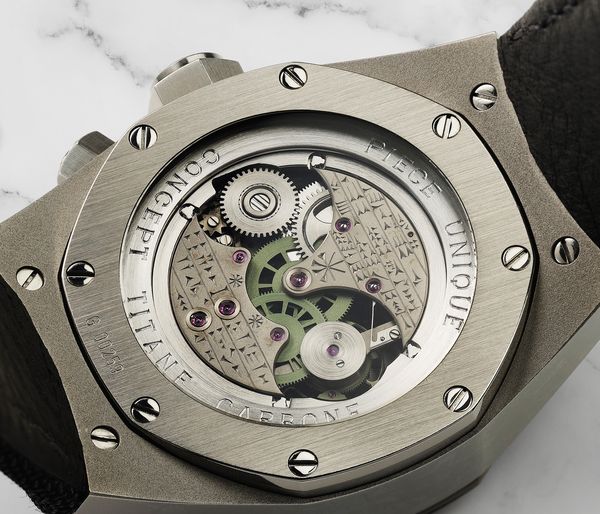It is hard to imagine now quite how much of a seismic shift the first Royal Oak Concept watch represented for Audemars Piguet when it was launched in 2002. One of the hallowed “Big Three”, alongside Patek Philippe and Vacheron Constantin, these companies are lauded for their exceptional craftsmanship and revered heritage but, with a few exceptions, are not renowned for their contemporary design languages or use of avant-garde materials. The Royal Oak Concept CW1 changed that.
Launched to commemorate the 30th anniversary of the original Royal Oak, which arrived as the reference 5402 “A-Series” in 1972 that has become so coveted by collectors, the Royal Oak Concept was not the first major update to the now iconic line. That arrived in 1992 for the 20th anniversary of the model, when Emmanuel Gueit turned his pen to the iconic Gérald Genta design language to create the Royal Oak Offshore, a line that has proven extremely successful for Audemars Piguet and has spawned many an imitator.
While the Offshore beefed up the proportions of the Royal Oak for a modern era and the addition of more complications, the Concept was a very different affair, that had the aim of introducing a futuristic design language utilising cutting edge materials, in addition to offering a canvas to showcase the very best of traditional complicated watchmaking techniques. Perhaps no easy task, but with Claude Emmenegger taking up the mantle for the aesthetics, and the now legendary Audemars Piguet Renaud & Papi handling the movement, there were certainly the right ingredients for success.
The externals of the watch deserve consideration first, as the case design is a fascinating examination of how instrumental the Concept was for the marketplace as we know it today. First it was particularly large for the era at 44mm, but the dimension has become very much the norm since, and its extended ergonomic curved form hangs over the wrist to make the piece eminently wearable. With the DNA of the Royal Oak clearly on display though the bezel and hexagonal “screws”, in profile its curve flows into the extended lugs that continue into a Kevlar (commonly used for ballistics protection) strap that is affixed with screws from the reverse.
The bezel is in lightweight titanium while the main body is made of alacrite 602, an alloy containing cobalt, chromium, tungsten nickel, iron and carbon, that was developed for the aerospace industry but has found further use in medical implants due to its biocompatibility, rather fitting for something sitting against one's skin. A big challenge was machining and finishing such a robust material, which was able to take on a beautiful polished surface that was highly scratch resistant but would wear out the tooling in the process. It might explain why, until now, the Concept is the one timepiece to have been produced in the material.
It is worth taking a moment to cover the relationship between Renaud & Papi and Audemars Piguet, one of the most strategic alliances of the contemporary watch industry, a format that has now become commonplace at other maisons. It is well known that Dominique Renaud and Giulio Papi found a start in Le Brassus before seeing an opportunity and setting up on their own, and their wild laboratory has become a fertile ground for many now established watchmakers, as well as brands looking for some technical magic, the most well-known of which, outside of Audemars Piguet (which helped fund the startup and was a majority shareholder), is Richard Mille. The firm would eventually be named Audemars Piguet Renaud & Papi (APRP) when the brand acquired the remaining stake in 2000.
Part of the magic of the Royal Oak Concept and its calibre is the way in which it displays the movement’s workings without being overbearing, showing a selection of the gears that run the calibre without feeling cluttered. The function selection for the winding and setting and the dynamographe that shows the torque in the barrel are diametrically opposed, providing balance, with the tourbillon mounted below its distractive snaking bridge on the “standard” watch (intended to provide increased shock protection), offering a symmetry to the 72-hour power reserve indicator. Of course, the finishing is to the highest standard, set against an avant-garde architecture.
The Concept was redefining in other ways as well; at the time, the packaging for watches was rather austere and a far cry from the elaborate set ups that we see today from several brands, but the Concept was perhaps the catalyst for a move to a more extravagant presentation, housed in an aluminium and perspex display case that adds a element of theatre to the unboxing experience. Produced in an edition of 150 pieces destined for Audemars Piguet’s most privileged clients, together with a small batch of unique pieces that featured an even more cutting edge carbon baseplate, straight tourbillon bridge, coloured gearing and uniquely engraved bridges to the reverse, those who acquired them have been particularly loyal, with few resurfacing.
The success of the Royal Oak Concept CW1 is exemplified by the fact that a reference originally intended as a short run has now spawned a whole model range, from the Concept Carbon in 2008, the Concept Laptimer Michael Schumacher in 2015, the Concept Supersonnerie in 2016 and even a more diminutive cased version in 2018 intended for those with smaller wrists, as well as a myriad of other interactions in between. A genre defining watch that has provided inspiration for so many, the Concept has firmly cemented its place in horological history.



